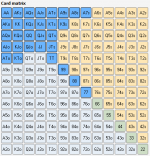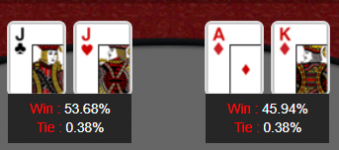You are using an out of date browser. It may not display this or other websites correctly.
You should upgrade or use an alternative browser.
You should upgrade or use an alternative browser.
uesleisuptitz
Enthusiast
Silver Level
I would probably choose AK in the same suit. It seems like it has more potential, even if it's expensive or crown most of the time.Você prefere ir all-in com JJ ou AK quando ainda não há cartas comunitárias?
primrose
Visionary
Bronze Level
It actually depends on how strong the opponent's range is. Although interestingly not in a linear way. For example, if you push all-in vs...
But the ranges where AKs does best are also some of the most relevant. E.g., a 15% range looks like this:

This is a pretty typical shoving range. Though then again, I guess you're always shoving both hands here so it doesn't matter. The only cases where it would be close is if a range gets even stronger, and then JJ does better again. So I guess JJ is the winner; there are rare cases where you should shove JJ but fold AKs (like the top 5% range!), whereas it seems like there is essentially no situation where you should ever shove AKs but fold JJ.
- the bottom 50% of hands (<- this is never relevant but just for demonstration), it's 67.4% vs. 83.3% equity (always listing AKs) first
- a 100% range, it's 67.1% vs. 77.5%
- a top 25% range, it's 65.4% vs. 66.3%
- a top 15% range, it's 63.2% vs. 61.6%
- a top 10% range, it's vs. 59.1% vs. 58.1%
- a top 5% range, it's 48.9% vs. 52.5%
- a top 3% range, 42.4% vs. 45.1%
But the ranges where AKs does best are also some of the most relevant. E.g., a 15% range looks like this:

This is a pretty typical shoving range. Though then again, I guess you're always shoving both hands here so it doesn't matter. The only cases where it would be close is if a range gets even stronger, and then JJ does better again. So I guess JJ is the winner; there are rare cases where you should shove JJ but fold AKs (like the top 5% range!), whereas it seems like there is essentially no situation where you should ever shove AKs but fold JJ.
dreamer13
Legend
Loyaler
In poker, ace-king versus pocket jacks is an example of a situational battle for preflop advantage. Although AK is considered a strong hand, JJ, as a pocket pair, has the advantage.The strength of AK depends on the specific situation, including the position at the table, the type of opponent and his tendency to be aggressive.








